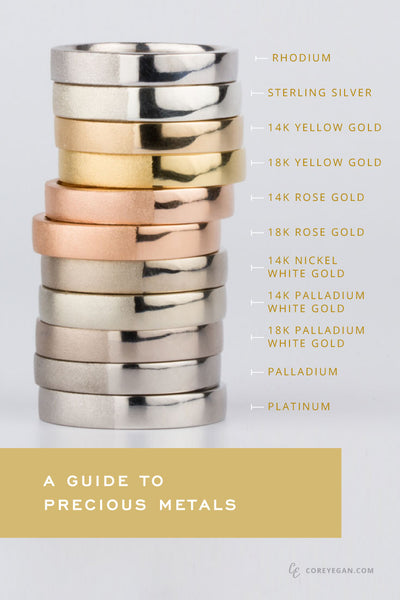Precious Metals Comparison for Fine Jewelry

When shopping for an important piece of jewelry, most of my clients have their hearts set on a particular design or style. But when asked about their precious metals preference, their responses get a bit hazy.
They might know which color metal they want but didn’t realize there would be multiple options within that color choice. And it can seem overwhelming to try to understand the physical properties of each option, let alone why one warrants a higher price tag than another.
Throughout this article, I hope to make all of this crystal clear. The precious metals I cover below are well-suited for special, heavily worn jewelry such as wedding bands or engagement rings. As you read through, consider how each metal will meet your needs on three fronts: color preference, lifestyle, and budget. Hope you enjoy!

GOLD COLORS AND KARATS
Gold has been used in the creation of jewelry since ancient times. It was revered for its sun-like color and ability to polish to a lustrous shine. Of all the precious metals for jewelry, gold offers the widest variety when it comes to color and level of purity.
Gold purity is measured in karats, and 100% pure gold is 24 karats. The 14k and 18k terms you’re likely familiar with come from how many parts per 24 are pure gold.
14 karat (14K) is 14/24 karats = 58.5% gold
18 karat (18K) is 18/24 karats = 75% gold

Pure 24k gold is actually quite soft and can’t withstand the natural wear and tear of everyday life. To strengthen it, it’s mixed with other metals, creating an alloy, which also alters its color.
Alloys with a higher karat number (like 18k) have a higher gold content, meaning the color will be yellower — closer to the natural pure gold hue.
Yellow gold is typically alloyed with copper, silver, and zinc.
Some of my favorite yellow gold items in my collection are: Aurora Diamond Studs, Small Helios Hoops, and the Borealis Necklace.
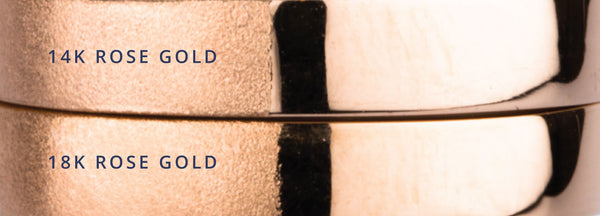
ROSE GOLD
Rose gold alloys have the same gold content as their yellow gold counterparts. They get their rosy color by being mixed with a larger portion of copper than silver and zinc.
Higher karat rose gold alloys will appear more peach since they contain more gold. Lower karat rose gold alloys have a larger dose of copper and will appear more pink.
Some of my favorite rose gold items in my collection are: rose gold wishbone studs, rose gold lucia studs, and the micro fragment diamond studs.
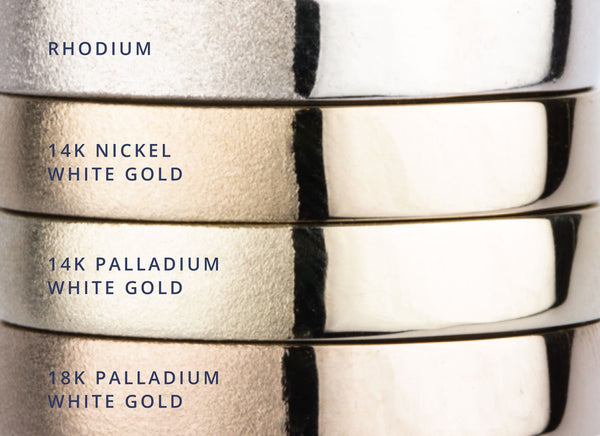
WHITE GOLD
The world of white gold gets more complicated since there are multiple mixture options. The main things to consider when choosing between white gold alloys are metal allergies, color preference, and maintenance.
NICKEL WHITE GOLD
Like rose gold, the color of white gold is attributed to the other metals in the mix. In traditional white gold alloys, nickel is used as a bleaching agent to remove the yellow color from the gold.
Some of my favorite nickel items in the collection are: the Lassen Band, Small white Gold Lucia Dangles, and the White Diamond Aurora Necklace
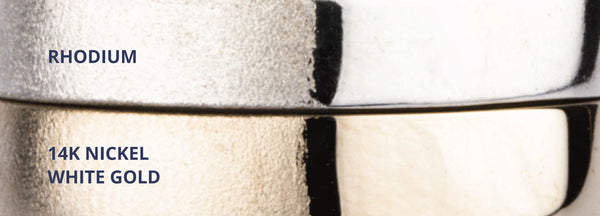
This alloy still appears slightly yellow and is commonly rhodium-plated. Most commercial white gold jewelry contains this layer of rhodium plating. While it gives the surface of the metal a bright white color, it eventually wears off. It will need to be reapplied every 1-2 years, but factoring in the wearer’s body chemistry and wearing habits, reapplication might need to happen as frequently as every 6 months.
In addition to the pesky maintenance of rhodium plating, nickel reactions are the most common metal allergy.
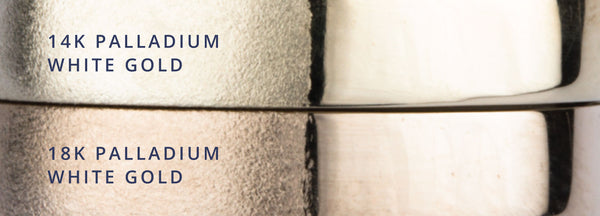
PALLADIUM WHITE GOLD
Palladium white gold alloys are a warm grayish-white. In this alloy of white gold, palladium is used as the bleaching agent to remove the yellow color from the gold, along with silver and copper. By using palladium instead of nickel in the mix, the resulting alloys are hypoallergenic. While it could be rhodium-plated for a bright white finish, I think they look excellent as-is, and many others agree!
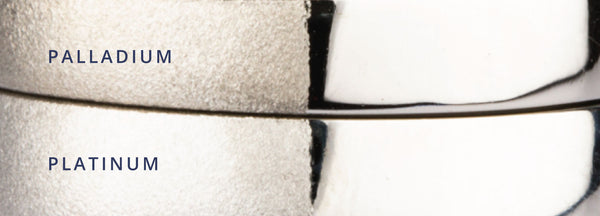
PALLADIUM
Palladium is a member of the Platinum Metals Group (PMG) on the periodic table and is more rare than gold. It's a naturally occurring grayish-white metal, just a touch darker than platinum, and is typically used in an alloy that is 95% pure palladium, mixed with another PMG member: ruthenium.
Palladium, by itself, is great for jewelry production. Its malleability makes it excellent for holding diamonds in place while still being durable enough to resist scratches better than platinum or white gold. Since it’s naturally white, there’s no need to rhodium-plate, so it’s lower maintenance. As a bonus, palladium is hypoallergenic.
Another important thing to note about palladium is its low density compared to other precious metals for jewelry. When comparing two identical pieces, the palladium piece will be lighter than matching ones in platinum or white gold. This makes it a great option for lightweight, comfortable wedding bands.
Over the past few years, the price of palladium has skyrocketed. Jewelry created in palladium was once an affordable alternative to 14k gold, but now it rivals the price of platinum.
Its purity, hypoallergenic quality, and low maintenance are the main reasons for choosing this alloy over white gold.
PLATINUM
Platinum has been used in precious jewelry for centuries. It’s a rare precious metal that is naturally grayish white in color. And like palladium, platinum is hypoallergenic and doesn’t require rhodium plating.
It polishes to an excellent shine and is very malleable, making it a great choice for setting stones in intricate designs. Platinum is also the densest of the precious metals for jewelry — a sturdiness needed for intricate filigree designs. The high density also lends itself well to setting large diamonds because prongs made of platinum will be more secure than ones made of white gold.
The malleability of platinum allows the metal's finish to develop a patina over time. Instead of losing metal when scratched, the surface of platinum is only displaced, slowly creating a rich matte finish that can easily be re-polished or re-textured.
Platinum is truly an heirloom-quality metal. Its physical properties make it a coveted option for jewelry designs that are created to last for generations. While it may be the most expensive of the precious metals for fine pieces, platinum jewelry is worth considering for its rarity, purity, and density.
Still have questions about how white metals perform head-to-head?
Read our white metals comparison for a deeper dive into your options.
